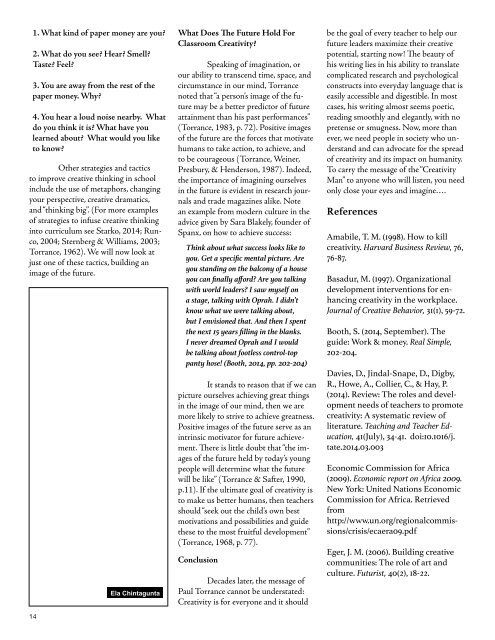Torrance Journal for Applied Creativity
TorranceJournal_V1
TorranceJournal_V1
You also want an ePaper? Increase the reach of your titles
YUMPU automatically turns print PDFs into web optimized ePapers that Google loves.
1. What kind of paper money are you?<br />
2. What do you see? Hear? Smell?<br />
Taste? Feel?<br />
3. You are away from the rest of the<br />
paper money. Why?<br />
4. You hear a loud noise nearby. What<br />
do you think it is? What have you<br />
learned about? What would you like<br />
to know?<br />
Other strategies and tactics<br />
to improve creative thinking in school<br />
include the use of metaphors, changing<br />
your perspective, creative dramatics,<br />
and “thinking big”. (For more examples<br />
of strategies to infuse creative thinking<br />
into curriculum see Starko, 2014; Runco,<br />
2004; Sternberg & Williams, 2003;<br />
<strong>Torrance</strong>, 1962). We will now look at<br />
just one of these tactics, building an<br />
image of the future.<br />
14<br />
Ela Chintagunta<br />
What Does The Future Hold For<br />
Classroom <strong>Creativity</strong>?<br />
Speaking of imagination, or<br />
our ability to transcend time, space, and<br />
circumstance in our mind, <strong>Torrance</strong><br />
noted that “a person’s image of the future<br />
may be a better predictor of future<br />
attainment than his past per<strong>for</strong>mances”<br />
(<strong>Torrance</strong>, 1983, p. 72). Positive images<br />
of the future are the <strong>for</strong>ces that motivate<br />
humans to take action, to achieve, and<br />
to be courageous (<strong>Torrance</strong>, Weiner,<br />
Presbury, & Henderson, 1987). Indeed,<br />
the importance of imagining ourselves<br />
in the future is evident in research journals<br />
and trade magazines alike. Note<br />
an example from modern culture in the<br />
advice given by Sara Blakely, founder of<br />
Spanx, on how to achieve success:<br />
Think about what success looks like to<br />
you. Get a specific mental picture. Are<br />
you standing on the balcony of a house<br />
you can finally af<strong>for</strong>d? Are you talking<br />
with world leaders? I saw myself on<br />
a stage, talking with Oprah. I didn’t<br />
know what we were talking about,<br />
but I envisioned that. And then I spent<br />
the next 15 years filling in the blanks.<br />
I never dreamed Oprah and I would<br />
be talking about footless control-top<br />
panty hose! (Booth, 2014, pp. 202-204)<br />
It stands to reason that if we can<br />
picture ourselves achieving great things<br />
in the image of our mind, then we are<br />
more likely to strive to achieve greatness.<br />
Positive images of the future serve as an<br />
intrinsic motivator <strong>for</strong> future achievement.<br />
There is little doubt that “the images<br />
of the future held by today’s young<br />
people will determine what the future<br />
will be like” (<strong>Torrance</strong> & Safter, 1990,<br />
p.11). If the ultimate goal of creativity is<br />
to make us better humans, then teachers<br />
should “seek out the child’s own best<br />
motivations and possibilities and guide<br />
these to the most fruitful development”<br />
(<strong>Torrance</strong>, 1968, p. 77).<br />
Conclusion<br />
Decades later, the message of<br />
Paul <strong>Torrance</strong> cannot be understated:<br />
<strong>Creativity</strong> is <strong>for</strong> everyone and it should<br />
be the goal of every teacher to help our<br />
future leaders maximize their creative<br />
potential, starting now! The beauty of<br />
his writing lies in his ability to translate<br />
complicated research and psychological<br />
constructs into everyday language that is<br />
easily accessible and digestible. In most<br />
cases, his writing almost seems poetic,<br />
reading smoothly and elegantly, with no<br />
pretense or smugness. Now, more than<br />
ever, we need people in society who understand<br />
and can advocate <strong>for</strong> the spread<br />
of creativity and its impact on humanity.<br />
To carry the message of the “<strong>Creativity</strong><br />
Man” to anyone who will listen, you need<br />
only close your eyes and imagine….<br />
References<br />
Amabile, T. M. (1998). How to kill<br />
creativity. Harvard Business Review, 76,<br />
76-87.<br />
Basadur, M. (1997). Organizational<br />
development interventions <strong>for</strong> enhancing<br />
creativity in the workplace.<br />
<strong>Journal</strong> of Creative Behavior, 31(1), 59-72.<br />
Booth, S. (2014, September). The<br />
guide: Work & money. Real Simple,<br />
202-204.<br />
Davies, D., Jindal-Snape, D., Digby,<br />
R., Howe, A., Collier, C., & Hay, P.<br />
(2014). Review: The roles and development<br />
needs of teachers to promote<br />
creativity: A systematic review of<br />
literature. Teaching and Teacher Education,<br />
41(July), 34-41. doi:10.1016/j.<br />
tate.2014.03.003<br />
Economic Commission <strong>for</strong> Africa<br />
(2009). Economic report on Africa 2009.<br />
New York: United Nations Economic<br />
Commission <strong>for</strong> Africa. Retrieved<br />
from<br />
http://www.un.org/regionalcommissions/crisis/ecaera09.pdf<br />
Eger, J. M. (2006). Building creative<br />
communities: The role of art and<br />
culture. Futurist, 40(2), 18-22.


